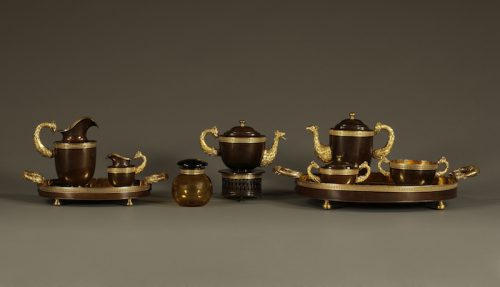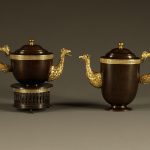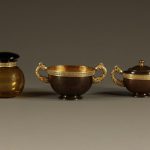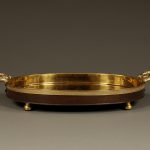11047 AN EXTRAORDINARY PATINATED AND GILT BRONZE TEA AND COFFEE SERVICE, POSSIBLY FROM THE DEMIDOV WORKSHOP Possibly Russian. First Quarter Of The Nineteenth Century.

Research
Of bronze, gilt bronze, and colored glass. Comprising two pitchers, one teapot, one coffee pot, a heating stand, an open bowl, a covered bowl, a colored glass tea caddy, a small tray and a large tray. All pieces, except the globular glass caddy, have sculpturally cast handles and spouts in the form of griffins with whimsical expressions. All display finely cast pierced and gilded bands. Gilding throughout the set is original, small isolated areas of localized re-gilding where worn.
Provenance:
A Copenhagen Private Collection
In its early introduction to Europe, “tea drinking was a socially prominent activity reserved for the upper class, and it required teawares that reflected this fashion and the position one held in society.”1 This remarkable tea and coffee service is distinguished not only by its unusual design, but also by its mode of manufacture. Each of the body pieces is made using the technique of the silversmith, whereby they were beaten over wooden formers, rather than cast. To this end, numerous tiny hammer marks can be detected on the gilded interiors. Gold is a noble metal, resistant to oxidation and corrosion by air and moisture, and its high purity renders the metal odorless and tasteless, providing a practical yet luxurious material for the linings of these vessels.
The spouts and handles take the form of griffin heads, with pointed ears and curved tongues issuing from their open beaks, a style of representation used in ancient Greece for the decoration of various vessels. A related example of one such bronze griffin head, dating from the seventh century BC, is in the Penn Museum of Archaeology and Anthropology (figure 1). This motif, as well as the use of bronze and gilding in teawares, can also be found in the Middle and Far East, in places such as Tibet and Asia Minor, and would have become an aesthetic influence as the Russian Empire expanded into Central Asia. The present interpretation of the griffins is characterized by their endearingly whimsical expressions.
A further strong indicator of the probable Russian origin of this set lies in the globular glass tea caddy, whose body is of an amber color, while the lid is dark purple. Amber was prized by the Russian nobility; an entire room in the Catherine Palace of Tsarskoye Selo was devoted to the material, and the royal collection contained numerous chests and other decorative objects in amber as well. Amber colored glass was also particularly favored by Russian glassworks. The great cut glass table, today in the Corning Museum of Glass, made by the Russian Imperial Glassworks, probably as a present from Tsar Alexander I to his mother or sister, has a flared central stem in this color. The purple color of the tea caddy lid can be found, probably exclusively, as the glass bowl section on a number of Russian gilt-bronze chandeliers.
Furthermore, Russia was known for its highly-sophisticated metalworking techniques, perfected at the Imperial Armory for the fashioning of weapons and armor and translated into the decorative arts. On the present service pierced gilt-bronze bands encircle the necks of each vessel, which are so delicately worked that they have the character of fine jewelry. The metals found in the Ural Mountains of Russia were mined by the Demidov family, whose workshops produced luxury and domestic items using copper, silver, and both precious and semiprecious stones. An eighteenth-century patinated and gilt-brass tea and coffee service, probably from the Demidov workshops, was in the Yves St. Laurent collection sold by Christie’s Paris (23-25 February 2009, Lot 184) and provides the only other example of a service using similar materials and techniques that we know of (figure 2). Like the present set, the interiors are gilded, and the spouts are formed as stylized griffin heads. Another clever and sophisticated feature is the use of a ring made from solid horn at the base of the handles of the vessels that hold the hot liquids. This non-conducting material ensures that heat is not transferred to the carrying handle.
Tea was first introduced to Russia in the mid-seventeenth century. In 1638 Tsar Alexei Mikhailovich’s ambassadors visited Mongolia in an attempt to make amends to a Kahn whom the Tsar had been dismissive toward. When the ambassadors were finally permitted to take their leave, the Kahn insisted they bring back 200 packets of tea, among other luxury goods, as a gift to the Tsar.2 Due to the geographic difficulties and expense of importing tea it was not enjoyed by the vast population as a common beverage until the 1870s. “At the beginning of the nineteenth century, tea drinking as an everyday social ritual, if it existed at all, was confined to the highest echelons of Russian society…The scarcity and high cost of tea limited its consumption to a small fraction of the Russian elite.”3 Coffee was introduced to Russia in the early eighteenth century and, like tea, would not become widely available until the end of the nineteenth century. Although it would never gain the same popularity as tea, coffee was enjoyed and encouraged by Peter the Great, as well as his wife Catherine I who customarily rose early and drank several cups of strong black coffee each morning.4 A service such as the present example would have been commissioned exclusively by a wealthy or aristocratic family for their enjoyment of these luxury beverages. The gilded interiors of each piece are a further indication of the sumptuousness of the commission.
Footnotes:
1. Heiss, Mary L, and Robert J. Heiss. The Story of Tea: A Cultural History and Drinking Guide. Berkeley, Calif: Ten Speed Press, 2007. 337.
2. Yoder, Audra Jo. “Myth and Memory in Russian Tea Culture.” Studies in Slavic Culture, Volume VIII. August 2009. 66. http://www.pitt.edu/~slavic/sisc/SISC8/yoder.pdf
3. Ibid.
4. Gorbatov, Inna. Catherine the Great and the French Philosophers of the Enlightenment: Montesquieu, Voltaire, Rousseau, Diderot and Grimm. Bethesda: Academica Press, 2006. 12.









Comments are closed.